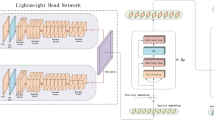Abstract
Sign language translation (SLT) is an active field of study that encompasses human-computer interaction, computer vision, natural language processing and machine learning. Progress on this field could lead to higher levels of integration of deaf people. This paper presents, to the best of our knowledge, the first continuous Argentinian Sign Language (LSA) dataset. It contains 14,880 sentence level videos of LSA extracted from the CN Sordos YouTube channel with labels and keypoints annotations for each signer. We also present a method for inferring the active signer, a detailed analysis of the characteristics of the dataset, a visualization tool to explore the dataset and a neural SLT model to serve as baseline for future experiments.
Access this chapter
Tax calculation will be finalised at checkout
Purchases are for personal use only
Similar content being viewed by others
References
Adaloglou, N., et al.: A comprehensive study on sign language recognition methods. arXiv preprint arXiv:2007.12530 2(2) (2020)
Borg, M., Camilleri, K.P.: Phonologically-meaningful subunits for deep learning-based sign language recognition. In: Bartoli, A., Fusiello, A. (eds.) ECCV 2020. LNCS, vol. 12536, pp. 199–217. Springer, Cham (2020). https://doi.org/10.1007/978-3-030-66096-3_15
Bragg, D., et al.: Sign language recognition, generation, and translation: an interdisciplinary perspective. In: The 21st International ACM SIGACCESS Conference on Computers and Accessibility, pp. 16–31 (2019)
Camgoz, N.C., Hadfield, S., Koller, O., Ney, H., Bowden, R.: Neural sign language translation. In: Proceedings of the IEEE Conference on Computer Vision and Pattern Recognition, pp. 7784–7793 (2018)
de Estadística y Censos, I.N.: Estudio nacional sobre el perfil de las personas con discapacidad: Resultados definitivos 2018 (2018)
y Empleos, E.B.: La lengua de señas argentina (lsa). https://idiomas.becasyempleos.com.ar/lengua-de-senas/, Accessed 28 May 2022
Fang, H.S., Xie, S., Tai, Y.W., Lu, C.: RMPE: regional multi-person pose estimation. In: Proceedings of the IEEE International Conference on Computer Vision, pp. 2334–2343 (2017)
Honnibal, M., Montani, I.: spaCy 2: natural language understanding with Bloom embeddings, convolutional neural networks and incremental parsing (2017). to appear
Huang, J., Zhou, W., Zhang, Q., Li, H., Li, W.: Video-based sign language recognition without temporal segmentation. In: Proceedings of the AAAI Conference on Artificial Intelligence, vol. 32 (2018)
Kim, Y., Kwak, M., Lee, D., Kim, Y., Baek, H.: Keypoint based sign language translation without glosses. arXiv preprint arXiv:2204.10511 (2022)
Ko, S.K., Kim, C.J., Jung, H., Cho, C.: Neural sign language translation based on human keypoint estimation. Appl. Sci. 9(13), 2683 (2019)
Koller, O.: Quantitative survey of the state of the art in sign language recognition. arXiv preprint arXiv:2008.09918 (2020)
Moore, B.E., Corso, J.J.: Fiftyone. GitHub. Note. https://github.com/voxel51/fiftyone (2020)
Ronchetti, F., Quiroga, F., Estrebou, C., Lanzarini, L., Rosete, A.: Sign languague recognition without frame-sequencing constraints: a proof of concept on the argentinian sign language. In: Montes-y-Gómez, M., Escalante, H.J., Segura, A., Murillo, J.D. (eds.) IBERAMIA 2016. LNCS (LNAI), vol. 10022, pp. 338–349. Springer, Cham (2016). https://doi.org/10.1007/978-3-319-47955-2_28
Ronchetti, F., Quiroga, F., Estrebou, C.A., Lanzarini, L.C., Rosete, A.: Lsa64: an argentinian sign language dataset. In: XXII Congreso Argentino de Ciencias de la Computación (CACIC 2016). (2016)
Sordos, C.: Cn sordos youtube channel (2020). https://www.youtube.com/channel/UCTi9woRHA4r8e3oEWF8hxTA, Accessed 12 May 2022
Stokoe, W.C.: Sign language structure. Ann. Rev. Anthropol. 9(1), 365–390 (1980)
Vaswani, A., et al.: Attention is all you need. Adv. Neural Inf. Process. Syst. 30 (2017)
Von Agris, U., Knorr, M., Kraiss, K.F.: The significance of facial features for automatic sign language recognition. In: 2008 8th IEEE International Conference on Automatic Face & Gesture Recognition, pp. 1–6. IEEE (2008)
Zhou, H., Zhou, W., Zhou, Y., Li, H.: Spatial-temporal multi-cue network for continuous sign language recognition. In: Proceedings of the AAAI Conference on Artificial Intelligence, vol. 34, pp. 13009–13016 (2020)
Author information
Authors and Affiliations
Corresponding author
Editor information
Editors and Affiliations
Rights and permissions
Copyright information
© 2022 The Author(s), under exclusive license to Springer Nature Switzerland AG
About this paper
Cite this paper
Dal Bianco, P. et al. (2022). LSA-T: The First Continuous Argentinian Sign Language Dataset for Sign Language Translation. In: Bicharra Garcia, A.C., Ferro, M., Rodríguez Ribón, J.C. (eds) Advances in Artificial Intelligence – IBERAMIA 2022. IBERAMIA 2022. Lecture Notes in Computer Science(), vol 13788. Springer, Cham. https://doi.org/10.1007/978-3-031-22419-5_25
Download citation
DOI: https://doi.org/10.1007/978-3-031-22419-5_25
Published:
Publisher Name: Springer, Cham
Print ISBN: 978-3-031-22418-8
Online ISBN: 978-3-031-22419-5
eBook Packages: Computer ScienceComputer Science (R0)




